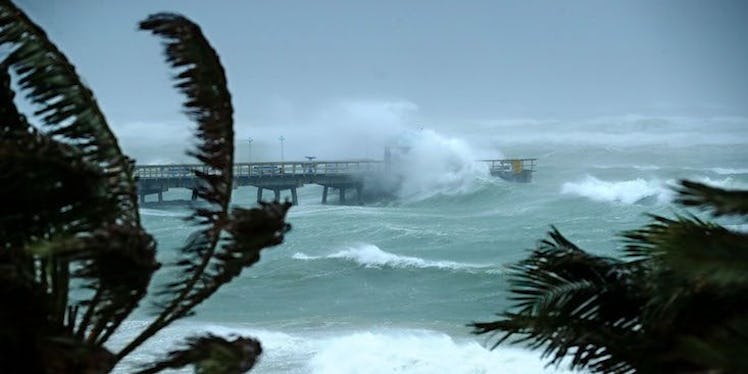
Hurricane Jose's Path Is Unclear And It's Driving People Crazy
Another strong storm is traveling through the Atlantic Ocean. This time, however, its course is much less certain than the last. After Hurricane Jose's path saw it downgrade to a tropical storm on Thursday, Sept. 14, meteorologists now say it could restrengthen into a hurricane again and then affect the U.S.
Where, exactly, it could hit the American mainland is unclear, which is a testament to the uncertainty of the storm's path. The National Hurricane Center (NHC) has warned that states along the east coast should be vigilant. The NHC said, per Fox News,
Interests from North Carolina northward to New England on the east coast of the United States should monitor the progress of this system.
On Friday morning, Jose was traveling with winds speeds up to 70 mph, which is below the threshold of a Category 1 hurricane. That threshold -- 74 mph -- is not far away, however, and the storm is expected to reach hurricane strength winds again later on Friday, NPR reports.
During the weekend, Jose is also expected to turn northward towards the Atlantic coastal states. Still, the storm is so far out that there's not yet cause for concern, one meteorologist says. Matt Scott of WTIC-TV, a Fox affiliate in Connecticut, told the Hartford Courant,
When we have this, we watch this critically. But five days out, we don't worry.
But with the uncertainty coming after the impact of two major hurricanes, people are going a little crazy over where Jose will end up.
Jose has already had an unpredictable path.
Hurricane Jose formed just after Hurricane Harvey hit the Gulf Coast area and before Hurricane Irma struck South Florida. At one point, there were fears that Jose would devastate Barbuda, just days after the tiny island had already been hammered by Irma.
The already small number of residents left on the island after Irma evacuations -- around 1,800 according to CNN's count -- had begun fleeing Barbuda in anticipation of Jose. However, Jose and its winds speeds, that were then up to 145 mph, skipped north of the island last weekend, sparing more damage.
The storm then proceeded to make an odd loop in the middle of the Atlantic ocean (which, by the way, was conducive to a few jokes).
Now comes the potential threat to the northeast, which gives a number of states a reason to watch its path closely. On Friday morning, the NHC said, per CNN,
Jose could produce other direct impacts next week along portions of the east coast of the United States from North Carolina northward to New England, but it is too soon to determine what those impacts might be or where they could occur.
As the National Hurricane Center's statement alludes, there is always an aspect of uncertainty that comes with projecting a storm's path. Jose's sparing of Barbuda is indicative of that uncertainty, and so to is the path that Hurricane Irma took through Florida this past weekend.
Ahead of the storm making landfall in the Sunshine State, meteorologists had practically reached a consensus that Irma would impact Florida via a "worst case scenario" path. Fox News meteorologist Janice Dean said at the time,
The core of the strongest winds are going to remain intact over the next 24 to 48 hours, and now we are coming into agreement that this will impact the Florida Keys and South Florida as possibly a worst case scenario with the worst of the storm surge, the worst of the winds, the worst of the rainfall.
The course of Irma's path saw unexpected developments however, namely a loss of strength while passing over Cuba and a turn that saw the eye travel west of Miami. Ultimately, despite the amount of damage Irma caused, the storm still spared Florida according to Rick Luettich, director of the University of North Carolina's Institute of Marine Sciences. Luettich told the New York Times,
The west coast of Florida still has plenty of disasters that are waiting to happen. This was really a best-case scenario, from a track perspective, for a storm this strong.
States along the east coast will be hoping for similar luck with Hurricane Jose.